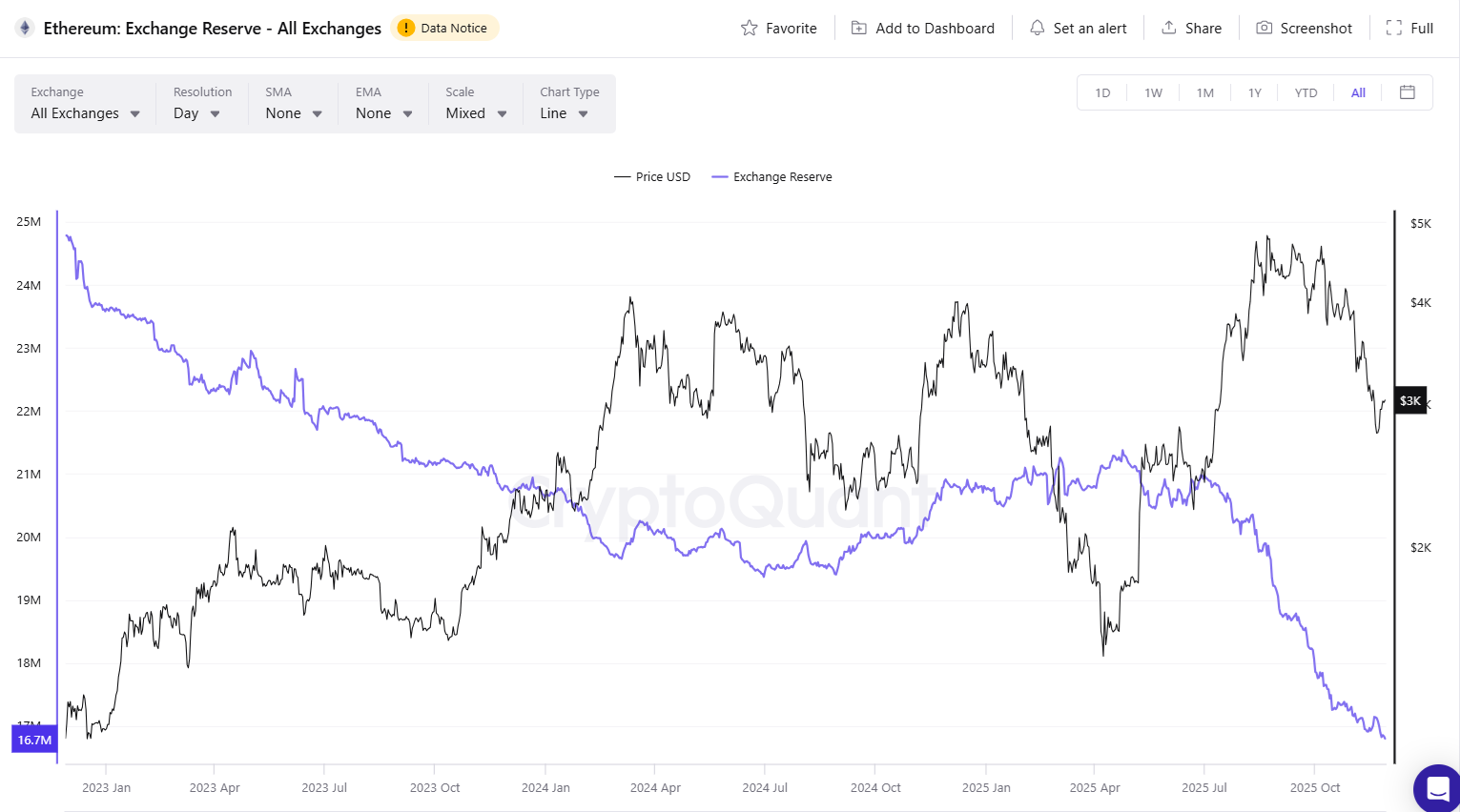ETH is currently trading near its fair value territory above $3,000, with a realized price of $2,315 and an MVRV ratio of 1.27, indicating neutral market conditions without signs of overbought status. Exchange reserves are at all-time lows, suggesting reduced selling pressure amid staking and DeFi activity.
-
ETH’s MVRV ratio at 1.27 signals fair valuation, 27% above realized price.
-
Neutral Fear and Greed Index at 49 points reflects balanced sentiment, avoiding hype-driven rallies.
-
Exchange reserves have dropped to 16 million ETH from 20 million in July, boosting accumulation in staking and DeFi protocols.
Discover why ETH’s price hovers near $3,000 in fair value territory. Explore MVRV ratios, declining reserves, and market neutrality for informed crypto insights. Stay updated on Ethereum trends today.
What is ETH’s Current Fair Value and Market Position?
ETH fair value is currently estimated around $3,000, based on key on-chain metrics like the realized price and MVRV ratio. As of late November 2025, Ethereum traded at $3,053.19, showing sideways movement without significant volatility. This positioning places ETH in a neutral zone, neither overbought nor oversold, supported by a Fear and Greed Index score of 49, which indicates balanced investor sentiment.
Ethereum’s market activity remains more dynamic than Bitcoin’s, driven by speculative interest, yet it lacks the exuberance of a full rally. On-chain data from platforms like CryptoQuant highlights that the realized price—representing the average cost basis of all ETH holders—stands at $2,315. The MVRV ratio, calculated as market value divided by realized value, sits at 1.27. This metric suggests the asset’s price is reasonably aligned with its underlying value, avoiding the extremes seen in past bull or bear cycles.
Historically, MVRV ratios above 3 have preceded market tops, while values below 1 signal capitulation and potential bottoms. At 1.27, ETH occupies mid-cycle territory, implying stability but vulnerability to corrections if liquidity dries up further. The absence of hype around an impending altcoin season or major network upgrades contributes to this subdued trading pattern, with ETH consolidating after recent recoveries.
Is ETH Experiencing a Shift in Market Structure?
Recent data from Binance shows a slightly lower MVRV ratio just under 1, hinting at possible changes in investor behavior and positioning ETH for either continued sideways action or a mild bottom formation. This threshold often correlates with shifts where holders begin accumulating more aggressively, especially among long-term investors and whales who have been lowering their average acquisition costs over years of market cycles.
Expert analysis from on-chain researchers, such as those at Glassnode, notes that such ratios reflect broader sentiment. When MVRV dips below 1, it typically means a majority of holders are underwater, prompting reduced selling and increased hodling. Conversely, levels above 3 have historically marked euphoria, leading to profit-taking and corrections. For ETH, the current setup—combined with peak network activity in DeFi and staking—suggests resilience, though derivative trading volumes have surged, providing liquidity without direct spot sales.
Whales, defined as addresses holding over 1,000 ETH, have played a pivotal role in this accumulation phase. Data indicates they’ve been actively acquiring during dips, using strategies like dollar-cost averaging to mitigate risks. This behavior contrasts with retail investors, who may react more to short-term price swings. Overall, the market structure appears stabilizing, but external factors like macroeconomic pressures could influence future trajectories.
Why Are ETH Exchange Reserves Declining?
ETH reserves on centralized exchanges have reached all-time lows, with total holdings at approximately 16 million ETH, down from 20 million in July 2025. This decline signals minimal immediate selling pressure, as holders increasingly move assets to staking, lending, or DeFi applications rather than keeping them on platforms prone to liquidation risks.
 ETH exchange reserves keep sinking to new all-time lows as holders shift to lending, staking, or DeFi. | Source: Cryptoquant
ETH exchange reserves keep sinking to new all-time lows as holders shift to lending, staking, or DeFi. | Source: CryptoquantBinance, the largest exchange by volume, holds about 3.87 million ETH, contributing to the overall trend. Long-term holders and institutional players prefer retaining ETH for yield-generating activities, such as staking on the Beacon chain or using it as collateral in decentralized protocols. This shift has accelerated wrapped ETH usage in trading, reducing the need for native tokens on exchanges.
According to reports from CryptoQuant, this pattern mirrors previous cycles where low reserves preceded price recoveries, as it limits supply available for sale. Staking participation has grown steadily, with over 30% of ETH supply now locked, providing network security while offering rewards to participants. DeFi platforms like Aave and Compound further incentivize this by allowing ETH to earn interest without custody risks. As a result, even amid neutral market conditions, ETH’s ecosystem demonstrates maturity, with reduced reliance on spot trading for liquidity.
The anticipation of the Fusaka update on December 3, 2025, adds another layer, potentially enhancing scalability and efficiency. While not yet driving hype, it underscores ETH’s evolution as a foundational blockchain. Network metrics show peak transaction volumes in smart contracts, yet price growth hasn’t fully mirrored this utility, pointing to untapped potential in a fair value regime.
Frequently Asked Questions
What Does ETH’s MVRV Ratio of 1.27 Mean for Investors?
An MVRV ratio of 1.27 for ETH indicates the asset is trading 27% above its realized price of $2,315, placing it in neutral territory. This suggests fair valuation without overextension, historically correlating with sideways trading rather than sharp rallies or drops. Investors should monitor for shifts below 1, which could signal buying opportunities amid accumulation.
How Might Declining ETH Exchange Reserves Impact Price Stability?
Declining ETH exchange reserves to 16 million tokens enhance price stability by reducing available supply for immediate sales. With more ETH moving to staking and DeFi, selling pressure eases, potentially supporting consolidation above $3,000. This trend, observed across major platforms, reflects growing confidence in Ethereum’s long-term utility and yield opportunities.
Key Takeaways
- Neutral Valuation Metrics: ETH’s MVRV at 1.27 and Fear and Greed Index at 49 confirm fair value positioning, ideal for accumulation without hype risks.
- Low Exchange Reserves: Holdings at all-time lows of 16 million ETH indicate strong hodling, with shifts to staking and DeFi limiting downside pressure.
- Market Structure Insights: Sideways trading persists ahead of the Fusaka update, urging investors to watch on-chain data for early signals of directional moves.
Conclusion
In summary, ETH’s fair value near $3,000, underpinned by a 1.27 MVRV ratio and declining exchange reserves, portrays a balanced Ethereum market in late 2025. Neutral indicators like the Fear and Greed Index at 49, coupled with robust network activity in staking and DeFi, highlight resilience amid subdued speculation. As the Fusaka update approaches on December 3, investors are positioned to benefit from potential efficiency gains—stay vigilant with on-chain metrics for emerging opportunities in this evolving landscape.
